
| ||||
|---|---|---|---|---|
 |
 |
 |
 |
 |



























| ||||
|---|---|---|---|---|
 |
 |
 |
 |
 |


























USMC Bell AH-1J SeaCobra
United States — USMC Twin-engine close support and attack helicopter
Archive Photos 1,2
Bell AH-1J SeaCobra (BuNo 157784) on display (6/22/2007) at the Flying Leatherneck Aviation Museum, MCAS Miramar, San Diego, California (Photos by John Shupek)
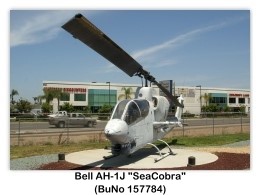
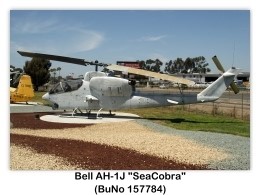

Bell AH-1J SeaCobra (BuNo 159224, c/n 26064) on display (10/6/2012) at the The U.S. Naval Museum of Armament and Technology, NAWS China Lake, California (Photos by Peter S. Kuntz)
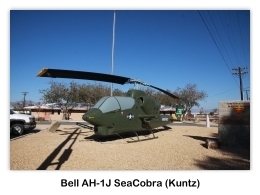
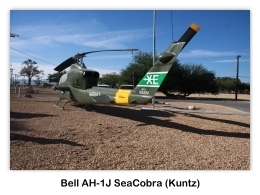
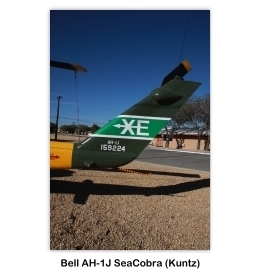
Bell AH-1J SeaCobra (BuNo 159227) on display (c.2000) at the Patuxent River Naval Air Museum, Lexington Park, MD (Photos by John Shupek)

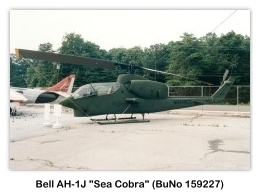
Overview 3
The Bell AH-1 SuperCobra is a Twin-engine attack helicopter based on the US Army’s AH-1 Cobra. The twin Cobra family includes the AH-1J SeaCobra, the AH-1T Improved SeaCobra, and the AH-1W SuperCobra. The Bell AH-1W is the backbone of the United States Marine Corps’s attack helicopter fleet, but will be replaced in service by the Bell AH-1Z Viper upgrade in the next decade.
Design and Development 3
The Bell AH-1 Cobra was developed in the mid-1960’s as an interim gunship for the U.S. Army for use in Vietnam. The Cobra shared the proven transmission, rotor system, and the T53 turboshaft engine of the Bell UH-1 Huey. By June 1967, the first Bell AH-1G HueyCobras had been delivered. Bell built 1,116 AH-1Gs for the U.S. Army between 1967 and 1973, and the Cobras chalked up over a million operational hours in Vietnam.
The U.S. Marine Corps was very interested in the Bell AH-1G Cobra, but preferred a Twin-engine version for improved safety in over-water operations, and also wanted a more potent turret-mounted weapon. At first, the Department of Defense had balked at providing the Marines with a Twin-engine version of the Cobra, in the belief that commonality with Army AH-1Gs outweighed the advantages of a different engine fit. However, the Marines won out and awarded Bell a contract for 49 Twin-engine AH-1J SeaCobras in May 1968. As an interim measure, the U.S. Army passed on 38 AH-1Gs to the Marines in 1969. The Bell AH-1J SeaCobra also received a more powerful gun turret. It featured a three barrel 20mm XM197 cannon that was based on the six barrel M61 Vulcan cannon.
The Marine Corps requested greater load carrying capability in high temperatures for the Cobra in the 1970s. Bell used systems from the Model 309 to develop the AH-1T. This version had a lengthened tailboom and fuselage with an upgraded transmission and engines from the 309. Bell designed the AH-1T to be more reliable and easier to maintain in the field. The version was given full TOW capability with targeting system and other sensors. An advanced version, known as the AH-1T+ with more powerful T700-GE-700 engines and advanced avionics was proposed to Iran in the late 1970s, but the overthrow of the Shah of Iran resulted in the sale being canceled.
In the early 1980s, the U.S. Marine Corps sought a new navalized helicopter, but was denied funding to buy the AH-64 Apache by Congress in 1981. The Marines in turn pursued a more powerful version of the AH-1T. Other changes included modified fire control systems to carry and fire AIM-9 Sidewinder and AGM-114 Hellfire missiles. The new version was funded by Congress and received the AH-1W designation. At least 266 were delivered.
The Bell AH-1T+ demonstrator and Bell AH-1W prototype was later tested with a new experimental composite four blade main rotor system. The new system offered better performance, reduced noise and improved battle damage tolerance. Lacking a USMC contract, Bell developed this new design into the AH-1Z with its own funds. By 1996, the Marines were again not allowed to order the AH-64. Developing a marine version of the Apache would have been expensive and it was likely that the Marine Corps would be its only customer. They instead signed a contract for upgrading 180 AH-1Ws into AH-1Zs.
The Bell AH-1Z Viper features several design changes. The Bell AH-1Z Viper’s two redesigned wing stubs are longer with each adding a wing-tip station for a missile such as the AIM-9 Sidewinder. Each wing has two other stations for 70 mm (2.75 in) Hydra rocket pods, or AGM-114 Hellfire quad missile launcher. The Longbow radar can be mounted on a wing tip station.
Operational History 3
During the closing months of the United States’ involvement in the Vietnam war, the Marine Corps embarked the Bell AH-1J SeaCobra assigned to HMA-369 (now HMLA-369) in USS Cleveland (LPD-7), and later USS Dubuque (LPD-8) for sea-based interdiction of the Ho Chi Minh Trail in North Vietnam in the vicinity of Hon La (Tiger) Island. These were termed Marine Hunter-Killer (MARHUK) Operations and lasted from June to December 1972.
Marine Cobras took part in the invasion of Grenada, during Operation Urgent Fury in 1983, flying close-support and helicopter escort missions. Two Marine Bell AH-1Ts were shot down and three crewmen killed. USMC Cobras participated in the Persian Gulf escort operations in the late 1980s, and sank three Iranian patrol boats while losing a single AH-1T to Iranian anti-aircraft fire. USMC Cobras from the USS Saipan flew "top cover" during an evacuation of American and other foreign nationals from Liberia in 1990.
During the 1983 Marine multinational force operations off the coast of Beirut, Lebanon during that nations civil war the AH-1 was deployed. Faced with the possibility of a threat involving the suicide delivery of airborne explosives loaded on light civil aircraft, the Bell AH-1s were employed armed with Sidewinder missiles and guns on a ready-alert status as an air defense asset in the absence of carrier based fixed wing cover or STOVL fighters.
During Operation Desert Shield in 1990, and Operation Desert Storm in Jan-Feb 1991, Cobras and SeaCobras deployed to Iraq in a support role. A total of 78 Marine SeaCobras flew 1,273 sorties with no combat losses. Three Bell AH-1s were lost in accidents during combat operations and afterwards. Marine Bell AH-1Ws destroyed 97 tanks, 104 armored personal carriers and vehicles, and two anti-aircraft artillery sites during the 100-hour ground campaign.
Iranian Bell AH-1J SeaCobras participated in air combat with Iraqi Mil Mi-24 Hinds on several separate occasions during the Iran-Iraq War. The results of these engagements are disputed. One document cited that "Iranian AH-1Js engaged Iraqi Mil MI-8 Hip and Mil MI-24 Hind helicopters. Unclassified sources report that the Iranian AH-1 pilots achieved a 10:1 kill ratio over the Iraqi helicopter pilots during these engagements (1:5). Additionally, Iranian AH-1 and Iraqi fixed wing aircraft engagements also occurred. Others claim that in the entire eight-year conflict, ten Iranian AH-1Js were lost in combat, compared to six Iraqi Mil Mi-24 Hinds. The skirmishes are described as fairly evenly matched in another source. Iranian AH-1Js are still operating today and have undergone indigenous upgrade programs. In 1988, two Soviet MiG-23s shot down a pair of Iranian AH-1Js that had strayed into western Afghan airspace.
Marine Cobras provided support for the US humanitarian intervention in Somalia, during Operation Restore Hope in 1992-1993. They were also employed during the US invasion of Haiti in 1994. USMC Cobras were used in US military interventions in the former Yugoslavia in the 1990s, and assisted in the rescue of USAF Captain Scott O’Grady 1995, after his F-16 was shot down by a SAM. The Turkish Army has been using its AH-1 gunships for their operations against rebel Kurds on both sides of the Iraqi border.
Bell AH-1 Cobras continue to operate with the U.S. Marine Corps. USMC Cobras were also used in operations throughout the 1990s. USMC Cobras have also served in Operation Enduring Freedom in Afghanistan and in Operation Iraqi Freedom in the ongoing conflict in Iraq. While new replacement aircraft were considered as an alternative to major upgrades of the AH-1 fleet, Marine Corps studies showed that an upgrade was the most affordable, most supportable and most effective solution for the Marine Corps light attack helicopter mission.
Variants 3
Twin-engine
Operators 3
Specifications AH-1J SeaCobra 3
General Characteristics
Performance
Armament
References